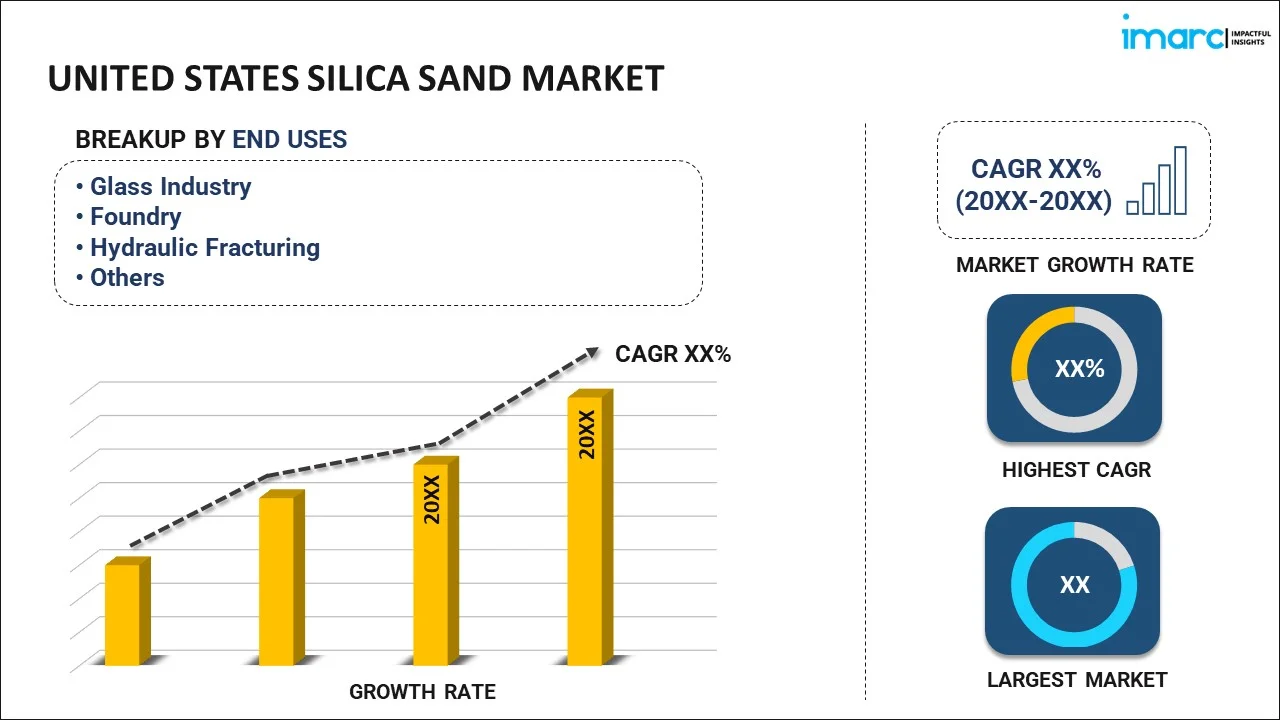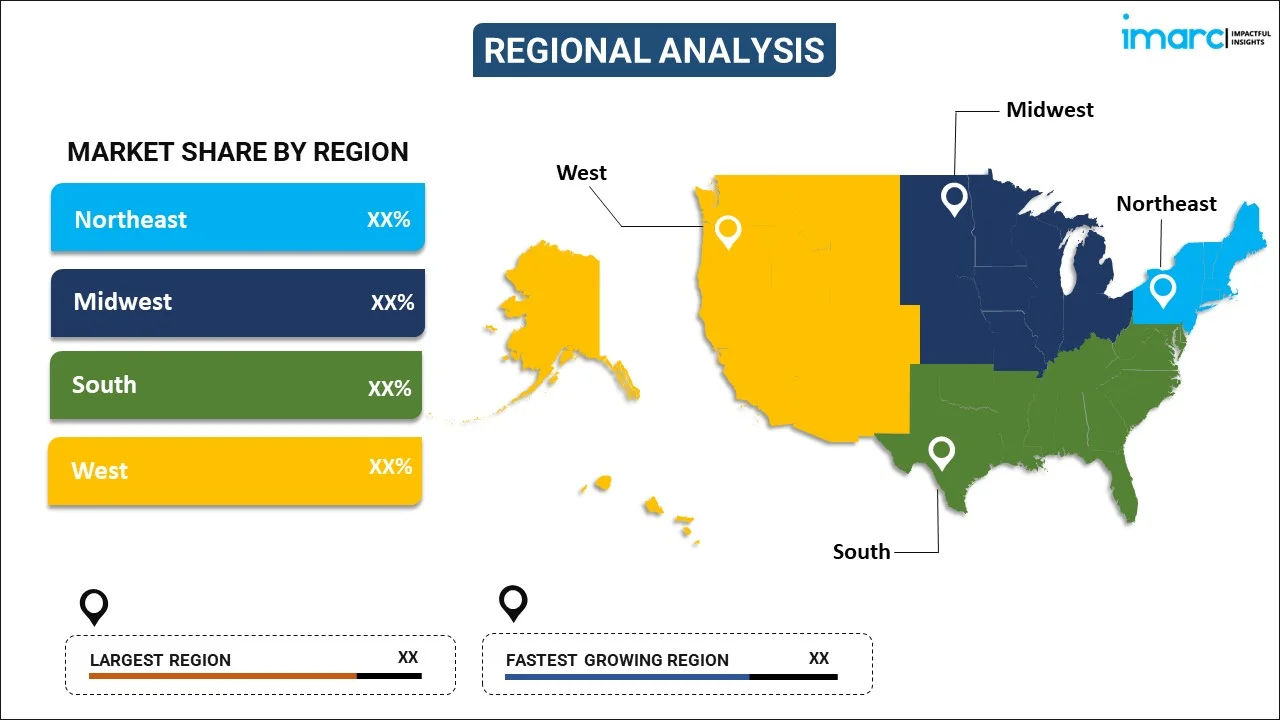
United States Silica Sand Market Report by End Use (Glass Industry, Foundry, Hydraulic Fracturing, Filtration, Abrasives, and Others), and Region 2025-2033
Market Overview:
The United States silica sand market size reached USD 6.3 Billion in 2024. Looking forward, IMARC Group expects the market to reach USD 10.3 Billion by 2033, exhibiting a growth rate (CAGR) of 5.03% during 2025-2033. The expanding construction industry, the increasing product demand in glass manufacturing, increasing exploration and extraction activities in the oil and gas sector, the rising product utilization in foundry industry, and the escalating product use in industrial abrasives are some of the factors propelling the market.
|
Report Attribute
|
Key Statistics
|
|---|---|
|
Base Year
|
2024 |
|
Forecast Years
|
2025-2033
|
|
Historical Years
|
2019-2024
|
| Market Size in 2024 | USD 6.3 Billion |
| Market Forecast in 2033 | USD 10.3 Billion |
| Market Growth Rate (2025-2033) | 5.03% |
Silica sand is a granular material composed of finely divided mineral and rock particles, primarily made up of silica, which is a compound of silicon and oxygen. It is one of the most abundant naturally occurring minerals on Earth and is commonly found in the form of quartz. It is characterized by its hardness, chemical inertness, and resistance to weathering. The main component of silica sand is silicon dioxide (SiO2), and it often contains small amounts of impurities such as iron oxide, alumina, and other minerals. The physical properties of silica sand, including its high melting point, make it a versatile and valuable material in various industrial applications. One of the prominent uses of silica sand is in the construction industry, where it serves as a primary component in the production of concrete and mortar. It provides stability and strength to building materials. Additionally, silica sand is a critical raw material in the manufacturing of glass, where its high purity and uniform grain size contribute to the clarity and strength of the final glass product. It also plays a crucial role in the oil and gas industry, particularly in hydraulic fracturing (fracking) operations. It is used as a proppant to keep fractures open and enhance the extraction of oil and natural gas from underground reservoirs. It finds applications in the foundry industry for molding and casting metals, as well as in various industrial abrasives for processes like sandblasting and grinding.
United States Silica Sand Market Trends:
The market in the United States is majorly driven by the expanding construction industry. As the country witnesses a rise in infrastructure development, residential construction, and commercial projects, the demand for silica sand as a fundamental construction material for concrete and mortar continues to escalate. Furthermore, the glass manufacturing sector is a significant contributor to the growth of the silica sand market in the U.S. The demand for glass products in various industries, including construction, automotive, and consumer goods, is on the rise. Silica sand, with its high purity and uniform grain size, remains a crucial raw material for the production of glass products, supporting the growth of the glass industry in the country. Hydraulic fracturing, a common method used for extracting oil and natural gas from underground reservoirs, relies heavily on silica sand as a proppant to enhance the efficiency of fracking operations. With the increasing number of exploration and extraction activities in the oil and gas sector, the demand for silica sand in hydraulic fracturing remains robust, thereby catalyzing the market. Besides, the foundry industry in the U.S. contributes to the market's growth, with silica sand being a key material for molding and casting metals. The automotive and manufacturing sectors, which heavily rely on metal casting processes, fuel the demand for silica sand in foundry operations. Additionally, the growing use of silica sand in industrial abrasives is strengthening the market growth. The country's metal fabrication industry, construction sector, and various manufacturing activities utilize industrial abrasives for applications like sandblasting and grinding, creating a sustained demand for silica sand. Environmental factors also play a role in the market growth. The U.S. emphasis on sustainable construction practices and energy-efficient building materials further enhances the demand for silica sand in eco-friendly construction projects, thereby fueling the market expansion.
United States Silica Sand Market Segmentation:
IMARC Group provides an analysis of the key trends in each segment of the market, along with forecasts at the country level for 2025-2033. Our report has categorized the market based on end use.
End Use Insights:

- Glass Industry
- Foundry
- Hydraulic Fracturing
- Filtration
- Abrasives
- Others
The report has provided a detailed breakup and analysis of the market based on the end use. This includes glass industry, foundry, hydraulic fracturing, filtration, abrasives, and others.
Regional Insights:

- Northeast
- Midwest
- South
- West
The report has also provided a comprehensive analysis of all the major regional markets, which include the Northeast, Midwest, South, and West.
Competitive Landscape:
The market research report has also provided a comprehensive analysis of the competitive landscape. Competitive analysis such as market structure, key player positioning, top winning strategies, competitive dashboard, and company evaluation quadrant has been covered in the report. Also, detailed profiles of all major companies have been provided. Some of the key players include:
- Badger Mining Corporation
- Covia Holdings LLC
- Manley Bros. of Indiana Inc.
- U.S. Silica Holdings Inc.
(Please note that this is only a partial list of the key players, and the complete list is provided in the report.)
United States Silica Sand Market Report Coverage:
| Report Features | Details |
|---|---|
| Base Year of the Analysis | 2024 |
| Historical Period | 2019-2024 |
| Forecast Period | 2025-2033 |
| Units | Billion USD |
| Scope of the Report | Exploration of Historical and Forecast Trends, Industry Catalysts and Challenges, Segment-Wise Historical and Predictive Market Assessment:
|
| End Uses Covered | Glass Industry, Foundry, Hydraulic Fracturing, Filtration, Abrasives, Others |
| Regions Covered | Northeast, Midwest, South, West |
| Companies Covered | Badger Mining Corporation, Covia Holdings LLC, Manley Bros. of Indiana Inc., U.S. Silica Holdings Inc., etc. |
| Customization Scope | 10% Free Customization |
|
Post-Sale Analyst Support |
10-12 Weeks |
| Delivery Format | PDF and Excel through Email (We can also provide the editable version of the report in PPT/Word format on special request) |
Key Questions Answered in This Report:
- How has the United States silica sand market performed so far and how will it perform in the coming years?
- What is the breakup of the United States silica sand market on the basis of end use?
- What are the various stages in the value chain of the United States silica sand market?
- What are the key driving factors and challenges in the United States silica sand?
- What is the structure of the United States silica sand market and who are the key players?
- What is the degree of competition in the United States silica sand market?
Key Benefits for Stakeholders:
- IMARC’s industry report offers a comprehensive quantitative analysis of various market segments, historical and current market trends, market forecasts, and dynamics of the United States silica sand market from 2019-2033.
- The research report provides the latest information on the market drivers, challenges, and opportunities in the United States silica sand market.
- Porter's five forces analysis assist stakeholders in assessing the impact of new entrants, competitive rivalry, supplier power, buyer power, and the threat of substitution. It helps stakeholders to analyze the level of competition within the United States silica sand industry and its attractiveness.
- Competitive landscape allows stakeholders to understand their competitive environment and provides an insight into the current positions of key players in the market.
Need more help?
- Speak to our experienced analysts for insights on the current market scenarios.
- Include additional segments and countries to customize the report as per your requirement.
- Gain an unparalleled competitive advantage in your domain by understanding how to utilize the report and positively impacting your operations and revenue.
- For further assistance, please connect with our analysts.
 Request Customization
Request Customization
 Speak to an Analyst
Speak to an Analyst
 Request Brochure
Request Brochure
 Inquire Before Buying
Inquire Before Buying




.webp)




.webp)












